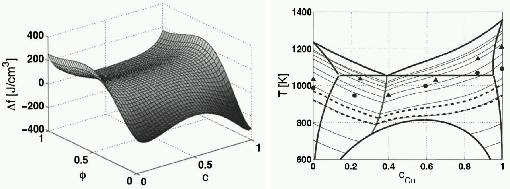
Gyula Tóth1, László Gránásy2,3
1Department of Mathematical Sciences, Loughborough University, Loughborough, Leicestershire, LE11 3TU, U.K.
2Institute for Solid State Physics and Optics, Wigner Research Centre for Physics, P.O. Box 49, Budapest H-1525, Hungary
3BCAST, Brunel University, Uxbridge, Middlesex, UB8 3PH, United Kingdom
The phase field theory PFT has been applied to predict equilibrium interfacial properties and nucleation barrier in the binary eutectic system AgCu using double well and interpolation functions deduced from a Ginzburg-Landau expansion that considers fcc face centered cubic crystal symmetries. The temperature and composition dependent free energies of the liquid and solid phases are taken from Calculation of Phase Diagrams-type calculations. The model parameters of PFT are fixed so as to recover an interface thickness of 1 nm from molecular dynamics simulations and the interfacial free energies from the experimental dihedral angles available for the pure components. A nontrivial temperature and composition dependence for the equilibrium interfacial free energy is observed. Mapping the possible nucleation pathways, we find that the Ag and Cu rich critical fluctuations compete against each other in the neighborhood of the eutectic composition. The Tolman length is positive and shows a maximum as a function of undercooling. The PFT predictions for the critical undercooling are found to be consistent with experimental results. These results support the view that heterogeneous nucleation took place in the undercooling experiments available at present. We also present calculations using the classical droplet model classical nucleation theory CNT and a phenomenological diffuse interface theory DIT. While the predictions of the CNT with a purely entropic interfacial free energy underestimate the critical undercooling, the DIT results appear to be in a reasonable agreement with the PFT predictions.


